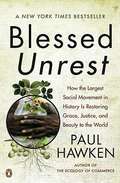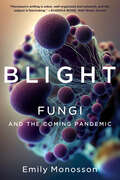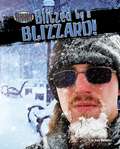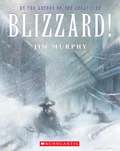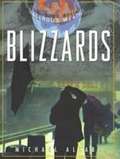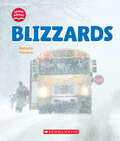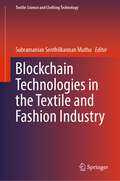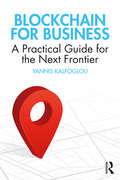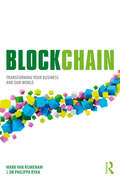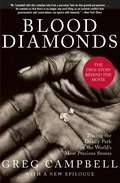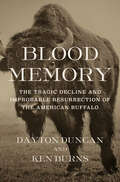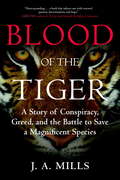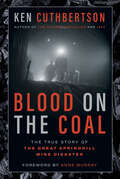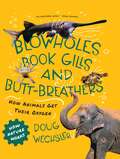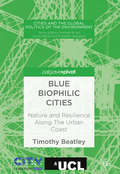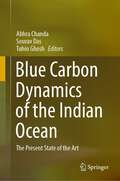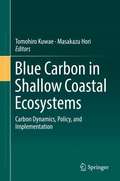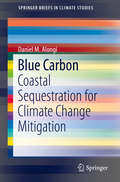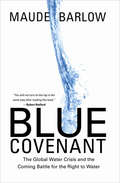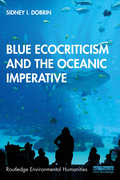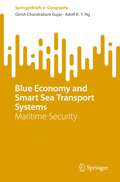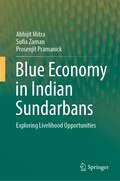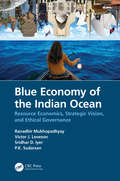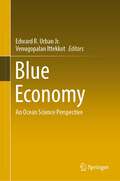- Table View
- List View
Blessed Unrest
by Paul HawkenOrganizations working to restore the environment and foster social justice collectively comprise the largest movement on earth. This movement with no name, leader, or location is a creative expression of people's needs worldwide.
Blight: Fungi and the Coming Pandemic
by Emily MonossonWinner of the 2024 Phi Beta Kappa Award for Science A New York Times Editors' Choice A Science News Favorite Book of 2023 "Fungi sicken us and fungi sustain us. In either case, we ignore them at our peril." —Elizabeth Kolbert, New York Review of Books A prescient warning about the mysterious and deadly world of fungi—and how to avert further loss across species, including our own. Fungi are everywhere. Most are harmless; some are helpful. A few are killers. Collectively, infectious fungi are the most devastating agents of disease on earth, and a fungus that can persist in the environment without its host is here to stay. In Blight, Emily Monosson documents how trade, travel, and a changing climate are making us all more vulnerable to invasion. Populations of bats, frogs, and salamanders face extinction. In the Northwest, America’s beloved national parks are covered with the spindly corpses of whitebark pines. Food crops are under siege, threatening our coffee, bananas, and wheat—and, more broadly, our global food security. Candida auris, drug-resistant and resilient, infects hospital patients and those with weakened immune systems. Coccidioides, which lives in drier dusty regions, may cause infection in apparently healthy people. The horrors go on. Yet prevention is not impossible. Tracing the history of fungal spread and the most recent discoveries in the field, Monosson meets scientists who are working tirelessly to protect species under threat, and whose innovative approaches to fungal invasion have the potential to save human lives. Delving into case studies at once fascinating, sobering, and hopeful, Blight serves as a wake-up call, a reminder of the delicate interconnectedness of the natural world, and a lesson in seeing life on our planet with renewed humility and awe.
Blitzed by a Blizzard! (Disaster Survivors)
by Joyce MarkovicsOn December 29, 2007, a fierce blizzard hit Olympia National Park in Washington State. Cross-country skier Randy Kraxberger, traveling alone, was caught by himself in the severe winter storm. Park rangers knew they had to save the lost skier. Could their daring rescue effort succeed through blinding snow, high winds, freezing temperatures, and the threat of avalanches? Safety tips show young readers how to stay out of harms way during a blizzard.
Blizzard! The Storm That Changed America
by Jim MurphySnow began falling over New York City on March 12, 1888. All around town, people struggled along slippery streets and sidewalks -- some seeking the warmth of their homes, some to get to work or to care for the less fortunate, and some to experience what they assumed would be the last little snowfall of one of the warmest winters on record. What no one realized was that in a very few hours, the wind and snow would bury the city in nearly 21 inches of snow and bring it to a ferocious standstill.<P><P> Winner of the Sibert Honor
Blizzards (Dangerous Weather)
by Michael AllabyRemain where you are . . . Dig a cave in the snow and shelter in it until conditions improve"-- this is Michael Allaby's advice to anyone caught outdoors in severe blizzard conditions known as "whiteouts." Wandering in search of shelter in such a storm would subject the pursuer to a featureless, disorienting whiteness, rendering senses useless and familiar landmarks unidentifiable. Blizzards describes what distinguishes a blizzard from an ordinary snowstorm, explains how blizzards develop and how they can deliver building-crushing volumes of snow, and chronicles dramatic blizzards of the past and the peculiar counter-intuitive measures required to survive these great white storms. The Dangerous Weather series imparts fundamental weather science to readers through author Michael Allaby's vivid descriptions of extreme weather systems. The series focuses on the five most dangerous kinds of weather activity; diagrams related meteorological, climatological, and environmental basics in clear, compelling language; chronicles the history of each form of dangerous weather; and offers safety precautions for extreme weather conditions. Fully illustrated and indexed, the Dangerous Weather series is an invaluable tool for student research. Other volumes include: hurricanes, tornadoes, floods droughts. Michael Allaby is the author of more than 40 books, mainly on science, natural environmental topics. A few of his previous works include Basics of Environment, The Weather: How It Works, The Environment, and The Concise Oxford Dictionary of Ecology.
Blizzards (Learn About)
by Natasha VizcarraLearn about wild weather events, including how to prepare for them, with this new series of fascinating books! A blizzard is a storm with high winds that blow snow around. It lasts for more than three hours. Experts say climate change is making these storms even fiercer. Discover why blizzards happen, how they are measured, and how we can prepare for them in Blizzards, a perfect first introduction to the topic for young readers.About This Series:In the era of climate change, wild weather events such as hurricanes, tornadoes, heat waves, and blizzards are becoming more frequent and more destructive. Now more than ever, education around these topics is essential. Using age-appropriate language and easy-to-understand science, the books in this series will offer a first exploration of different wild weather events that can be unleashed on Earth: why they happen, how they are measured, and how we can prepare for them. Illustrated with arresting full-color photography and sprinkled with fascinating facts, these books will follow pioneering climate change curricula for early elementary grades across the United States.
Blizzards (World Book's Library of Natural Disasters)
by Philip Steele"A discussion of a major type of natural disaster, including descriptions of some of the most destructive; explanations of these phenomena, what causes them, and where they occur; and information about how to prepare for and survive these forces of nature. Features include an activity, glossary, list of resources, and index"--Provided by publisher. This is the second edition.
Blockchain Technologies in the Textile and Fashion Industry (Textile Science and Clothing Technology)
by Subramanian Senthilkannan MuthuThis book presents applications of blockchain technologies to foster sustainable development in the textile and clothing supply chain. The concept of Textiles and Fashion Sustainability has grown to a wider extent today. Among the list of items to achieve Sustainability in Textiles and Fashion, the key element is the traceability of supply chains in terms of mapping and tracing the entire supply chain to ensure sustainable supply chain management. Reliable and transparent, efficient data is one of the crucial requirements for Textiles and Fashion Sustainability in today’s advanced industrial context and this is possible in this advanced era by various technological advancements such as Block chain technologies. These days one can see a widespread application of blockchain technology in the Textiles and Clothing sector. The core competencies of blockchain technology namely transparency, data auditability, privacy, value transfer, and process efficiency and automation are very much essential for achieving the multifold objectives under the theme Textiles and Fashion Sustainability.
Blockchain for Business: A Practical Guide for the Next Frontier
by Yannis KalfoglouThis book sets out to explain blockchain for the non-technical expert, to decipher the dense technicalities that dominate the field and to present the opportunities for busy professionals using practical applications and case studies. Presented in a clear and structured way and with documented real-world cases, the book is a practical reference guide that can be used across different industries. It offers both a constructive and critical review of the pain points blockchain is facing today, illustrates the pitfalls as well as the opportunities for business and describes the steps towards overcoming them. It also aims to provide a unique view of both the intersection and synergy of blockchain with other emerging technologies and the wider digital ecosystem, as we see increasingly that blockchain alone won’t be able to deliver business solutions. Most important, the book identifies trends and a path for the future of blockchain and its impact on society as a whole. The book is written for business audiences across all sectors. It is not a technical guide to blockchain, but it enables businesspeople to be better informed and prepared to plan ahead and develop strategies using blockchain.
Blockchain: Transforming Your Business and Our World
by Mark Van Rijmenam Philippa RyanThe internet was envisaged as a decentralised global network, but in the past 25 years it has come to be controlled by a few, very powerful, centralised companies. Blockchain is a technological paradigm shift that allows secure, reliable, and direct information transfer between individuals, organisations, and things, so that we can manage, verify, and control the use of our own data. Blockchain also offers a new opportunity for humanity to fix some major problems. It can authenticate data, manage its analysis, and automate its use. With better data comes better decision-making. In this way, Blockchain can contribute to solving climate change, reduce voting fraud, fix our identity systems, improve fair trade, and give the poor an opportunity to improve their lives by monetising their (digital) capital. A world built upon peer-to-peer transactions and smart contracts can empower individuals and communities. This book offers a fresh perspective with which to consider this transformative technology. It describes how Blockchain can optimise the processes that run our society. It provides practical solutions to global problems and offers a roadmap to incorporate Blockchain in your business. It offers a blueprint for a better world. Filled with easy-to-understand examples, this book shows how Blockchain can take over where the internet has fallen short.
Blood Diamonds: Tracing the Deadly Path of the World's Most Precious Stones
by Greg CampbellFirst discovered in 1930, the diamonds of Sierra Leone have funded one of the most savage rebel campaigns in modern history. These "blood diamonds" are smuggled out of West Africa and sold to legitimate diamond merchants in London, Antwerp, and New York, often with the complicity of the international diamond industry. Eventually, these very diamonds find their way into the rings and necklaces of brides and spouses the world over. Blood Diamonds is the gripping tale of how the diamond smuggling works, how the rebel war has effectively destroyed Sierra Leone and its people, and how the policies of the diamond industry - institutionalized in the 1880s by the De Beers cartel - have allowed it to happen. Award-winning journalist Greg Campbell traces the deadly trail of these diamonds, many of which are brought to the world market by fanatical enemies. These repercussions of diamond smuggling are felt far beyond the borders of the poor and war-ridden country of Sierra Leone, and the consequences of overlooking this African tragedy are both shockingly deadly and unquestionably global. Updated with a new epilogue.
Blood Memory: The Tragic Decline and Improbable Resurrection of the American Buffalo
by Ken Burns Dayton DuncanThe epic story of the buffalo in America, from prehistoric times to today—a moving and beautifully illustrated work of natural historyThe American buffalo—our nation&’s official mammal—is an improbable, shaggy beast that has found itself at the center of many of our most mythic and sometimes heartbreaking tales. The largest land animals in the Western Hemisphere, they are survivors of a mass extinction that erased ancient species that were even larger. For nearly 10,000 years, they evolved alongside Native people who weaved them into every aspect of daily life; relied on them for food, clothing, and shelter; and revered them as equals.Newcomers to the continent found the buffalo fascinating at first, but in time they came to consider them a hindrance to a young nation&’s expansion. And in the space of only a decade, they were slaughtered by the millions for their hides, with their carcasses left to rot on the prairies. Then, teetering on the brink of disappearing from the face of the earth, they would be rescued by a motley collection of Americans, each of them driven by different—and sometimes competing—impulses. This is the rich and complicated story of a young republic's heedless rush to conquer a continent, but also of the dawn of the conservation era—a story of America at its very best and worst.
Blood of the Tiger
by J. A. MillsBlood of the Tiger takes readers on a wild ride to save one of the world's rarest animals from a band of Chinese billionaires. Many people think wild tigers are on the road to recovery, but they are in greater danger than ever--from a menace few experts saw coming. There may be only three thousand wild tigers left in the entire world. More shocking is the fact that twice that many--some six thousand--have been bred on farms, not for traditional medicine but to supply a luxury-goods industry that secretly sells tiger-bone wine, tiger-skin décor, and exotic cuisine enjoyed by China's elite. Two decades ago, international wildlife investigator J. A. Mills went undercover to expose bear farming in China and discovered the plot to turn tigers into nothing more than livestock. Thus begins the story of a personal crusade in which Mills mobilizes international forces to awaken the world to a conspiracy so pervasive that it threatens every last tiger in the wild. In this memoir of triumph, heartbreak, and geopolitical intrigue, Mills and a host of heroic comrades try to thwart a Chinese cadre's plan to launch billion-dollar industries banking on the extinction of not just wild tigers but also elephants and rhinos. Her journey takes her across Asia, into the jungles of India and Nepal, to Russia and Africa, traveling by means from elephant back to presidential motorcade, in the company of man-eaters, movie stars, and world leaders. She finds reason for hope in the increasing number of Chinese who do not want the blood of the last wild tigers to stain their beloved culture and motherland. Set against the backdrop of China's ascendance to world dominance, Blood of the Tiger tells of a global fight to rein in the forces of greed on behalf of one of the world's most treasured and endangered animals. From the Hardcover edition.
Blood on the Coal: The True Story of the Great Springhill Mine Disaster
by Ken CuthbertsonThe riveting true story of one of Canada’s worst mining disasters, told in the voices of the men who survived itThey said it was the world’s deepest and most dangerous coal mine. Those who made that claim were probably correct. What is certain is that in October 1958, the Dominion Steel and Coal Corporation’s No. 2 colliery at Springhill, Nova Scotia, was a leading candidate for both those dubious distinctions. The mine was the proverbial “disaster waiting to happen.” And it did. Springhill was the quintessential one-industry town, whose existence depended on coal, a commodity with a dying market. And yet something far worse was soon to come. On the night of October 23, 1958, a “bump” in the mine—actually a small earthquake—shook the ground beneath the town. Seventy-five miners died and scores more were injured in what remains one of Canada’s worst underground disasters. The lives of the survivors were shattered, and Springhill would never be the same again. In compelling detail, Ken Cuthbertson tells the stories of three of the miners and one of the doctors who cared for them following the disaster. This remarkable book is based on historical documents and interviews, as well as new interviews with the last of the surviving miners and their loved ones. It is a story of heroism, sacrifice and the indomitable strength of the human spirit.
Blowholes, Book Gills, and Butt-Breathers: The Strange Ways Animals Get Oxygen (How Nature Works #0)
by Doug WechslerSpectacular nature photography: Weird and wonderful, as only nature can be! Explores a question unasked by any other book for young readers: What can we learn about nature and evolution from the bizarre and exotic ways some animals have evolved to get life-giving oxygen? An inquiry-based book designed to stimulate active minds; a STEM standout from a celebrated nature photographer and writer.
Blue Biophilic Cities: Nature and Resilience Along The Urban Coast (Cities and the Global Politics of the Environment)
by Timothy BeatleyThere is a growing recognition of the contact we need with nature to be happy, healthy and to lead meaningful lives. We need that nature daily, if not hourly, and so it must be nearby to where we live and work. This is central to the concept of 'biophilic cities' which is emerging as a global movement and guiding framework for city design and planning. Blue Biophilic Cities is about the promise of this movement and a kind of biophilic urbanism that is possible for cities perched on the edge of harbours and seas. In blue biophilic cities, much of the nearby nature is to be found in the marine realm. This book explores the efforts underway in a number of cities to foster new marine connections through a variety of innovative programs and initiatives. It also discusses a number of design ideas, from dynamic shoreline edges and floodable parks to living breakwaters, in order to emphasise the possibility of designing for resilience while also supporting marine biodiversity and strengthening biophilic connections to the marine world.
Blue Carbon Dynamics of the Indian Ocean: The Present State of the Art
by Tuhin Ghosh Sourav Das Abhra ChandaThis book gives an overview of various aspects of blue carbon dynamics from each country bordering the Indian Ocean. Given the importance of the topic of blue carbon, it can be assumed that in near future, more and more researchers from the Indian Ocean countries will pursue environmental research in this domain. This book is a ready reference to all those who are interested to have a holistic understanding about the ground scenario of blue carbon in the Indian Ocean. There are many research institutes situated in the periphery of the Indian Ocean that are devoted to nurturing the new avenues of marine carbon research. Researchers and scholars interested in this domain will find this book provides a good overview, wherein all the necessary information on the status and functioning of these blue carbon ecosystems are detailed in a concise way. The book is also helpful to postgraduate students of ‘marine science’ or those who have a specialization in ‘marine biogeochemistry’ or ‘chemical oceanography’ to develop a basic understanding about the very concept of ‘blue carbon’ from the perspective of the Indian Ocean.
Blue Carbon in Shallow Coastal Ecosystems: Carbon Dynamics, Policy, And Implementation
by Tomohiro Kuwae Masakazu HoriThis book presents a comprehensive and innovative understanding of the role of shallow coastal ecosystems in carbon cycling, particularly marine carbon sequestration. Incorporating a series of forward-looking chapters, the book combines thorough reviews of the global literature and regional assessments—mainly around the Indo-Pacific region and Japan—with global perspectives to provide a thorough assessment of carbon cycling in shallow coastal systems. It advocates the expansion of blue-carbon ecosystems (mangroves, seagrass meadows, and salt marshes) into macroalgal beds, tidal flats, coral reefs, and urbanized shallow waters, demonstrating the potential of these ecosystems as new carbon sinks. Moreover, it discusses not only topics that are currently the focus of blue-carbon studies, i.e., sedimentary carbon stock and accumulation rate, but also CO2 gas exchange between the atmosphere and shallow coastal ecosystems, carbon storage in the water column as refractory organic carbon, and off-site carbon storage. Including highly original contributions, this comprehensive work inspires research beyond the specific regions covered by the chapters. The suite of new concepts and approaches is refreshing and demonstrates that blue-carbon research is indeed a vibrant new field of research, providing deep insights into neglected aspects of carbon cycling in the marine environment. At the same time the book provides guidance for policy makers to deliver benefits to society, for example the inclusion of blue carbon as a carbon offset scheme or the Nationally Determined Contribution (NDC) in the Paris Agreement, and also for building resilience in coastal socio-ecosystems through better management. This book is intended for all those interested in the science and management of coastal ecosystems.
Blue Carbon: Coastal Sequestration for Climate Change Mitigation (SpringerBriefs in Climate Studies)
by Daniel M. AlongiThis work summarizes the science and management of a rapidly expanding topic in climate science, namely adaptation and mitigation. The term 'blue carbon' refers to the rates, pathways and volumes of greenhouse carbon sequestered in coastal estuarine and marine ecosystems such as salt marshes, mangroves and seagrass meadows. Blue carbon and its vital role in climate change mitigation are central to this book.Readers find summaries and analysis of both the basic scientific data and data from blue carbon field projects, and a practical guide on how to manage a successful blue carbon field project. There is a discussion on how to maximize the carbon sequestration and consideration of whether blue carbon projects make a difference.The work is not only of interest to scholars involved in climate science, but also those in the marine sciences, and those in ecosystem ecology, biogeochemistry; geochemistry; estuarine and marine plant ecology.
Blue Covenant: The Global Water Crisis and the Coming Battle for the Right to Water
by Maude BarlowA cautionary account of climate change and the global water supply. &“You will not turn on the tap in the same way after reading this book.&” —Robert Redford In a book hailed by Publishers Weekly as a &“passionate plea for access-to-water activism,&” Blue Covenant addresses an environmental crisis that—together with global warming—poses one of the gravest threats to our survival. How did the world&’s most vital resource become imperiled? And what must we do to pull back from the brink? In &“stark and nearly devastating prose&”, world-renowned activist and bestselling author Maude Barlow—who is featured in the acclaimed documentary Flow—discusses the state of the world&’s water. Barlow examines how water companies are reaping vast profits from declining supplies, and how ordinary people from around the world have banded together to reclaim the public&’s right to clean water, creating a grassroots global water justice movement. While tracing the history of international battles for the right to water, she documents the life-and-death stakes involved in the fight and lays out the actions that we as global citizens must take to secure a water-just world for all (Booklist). &“Sounds the water alarm with conviction and authority.&” —Kirkus Reviews &“This book proves that water deserves another destiny.&” —Eduardo Galeano &“Blue Covenant will inspire civil society movements around the world.&” —Vandana Shiva
Blue Ecocriticism and the Oceanic Imperative (Routledge Environmental Humanities)
by Sidney I. DobrinThis book initiates a conversation about blue ecocriticism: critical, ethical, cultural, and political positions that emerge from oceanic or aquatic frames of mind rather than traditional land-based approaches. Ecocriticism has rapidly become not only a disciplinary legitimate critical form but also one of the most dynamic, active criticisms to emerge in recent times. However, even in its institutional success, ecocriticism has exemplified an "ocean deficit." That is, ecocriticism has thus far primarily been a land-based criticism stranded on a liquid planet. Blue Ecocriticism and the Oceanic Imperative contributes to efforts to overcome ecocriticism’s "ocean-deficit." The chapters explore a vast archive of oceanic literature, visual art, television and film, games, theory, and criticism. By examining the relationships between these representations of ocean and cultural imaginaries, Blue Ecocriticism works to unmoor ecocriticism from its land-based anchors. This book aims to simultaneously advance blue ecocriticism as an intellectual pursuit within the environmental humanities and to advocate for ocean conservation as derivative of that pursuit.
Blue Economy and Smart Sea Transport Systems: Maritime Security (SpringerBriefs in Geography)
by Adolf K. Ng Girish Chandrakant GujarFocusing on maritime security, this book discusses Blue Economy and Smart sea transport systems in the context of the Indian Ocean rim countries and the multifaceted challenges that they are likely to face while attempting to develop such systems. It introduces Blue Economy as a concept with an emphasis on lower costs, reduced waste, greater efficiency, and value addition in all services associated with the near and deep oceans, with the establishment of Smart sea transport systems as the adaptive response in a global trade system. It highlights the roles of maritime security in politics, economics, and environmental management issues that constitute the challenges of achieving such goals. In this regard, the authors approach the issues from the institutional perspective to examine ways in which relevant transport and supply chain stakeholders can collaborate to build secure, resilient global systems of maritime trade. This book will be of interest to anyone interested in marine policy and global supply chains, especially in maritime security, its impacts and risks on transport and supply chain infrastructures, and the related socioeconomic activities likely to be affected. Readers will gain insight into the effective ways to adapt to such risks and how to benefit from the generated opportunities on transport, supply chains, and the global economy. Also, it is an ideal companion to policymakers and practitioners who are eager to learn about the dynamics between maritime security and Blue Economy which, in turn, enhances the quality of strategic planning, policies, and practices in addressing these issues. Finally, it inspires researchers and postgraduate students to conduct innovative research on this topic.
Blue Economy in Indian Sundarbans: Exploring Livelihood Opportunities
by Abhijit Mitra Sufia Zaman Prosenjit PramanickThis book provides a cross-sectoral, multidisciplinary assessment of the major verticals of Blue Economy relevant to the mangrove ecosystem in Indian Sundarbans, which is a deltaic complex at the apex of Bay of Bengal. This book evaluates the feasibility of Blue Economy considering the natural resource base in this mangrove dominated deltaic complex.Chapter 1 discusses the need of expanding different marine and estuarine oriented verticals of Blue Economy as the land resources are gradually becoming depleted. Chapter 2 highlights the wide spectrum of biotic and abiotic resources of the Indian Sundarbans which can serve as the strong foundation of expanding Blue Economy in the region. Chapter 3 highlights several mangrove based livelihoods that are not only innovative, but may present new opportunities to initiate cottage industries. Chapter 4 highlights the threats associated with Blue Economy in Indian Sundarbans like, sea level rise, acidification of water, weather extremes, pollution, over-exploitation of natural resources, etc., along with ground-zero environmental data collated over three decades. Chapter 5 offers several solutions to combat the threats to regional Blue Economy emphasizing both technology and policy based management. The book attempts to align the proliferation of different sectors of Blue Economy in the framework of Indian Sundarbans.
Blue Economy of the Indian Ocean: Resource Economics, Strategic Vision, and Ethical Governance
by Ranadhir Mukhopadhyay Victor J. Loveson Sridhar D. Iyer P.K. SudarsanThe economic paradigms currently dominating the world are not sustainable. The threats from climate change, exploitation-based approaches to commerce, and the excess acquisition of resources loom large as well as the possibility of military flare-ups. Maintaining a balance between development and ecosystems, aspirations for growth, and the need for sustainability is a prescient challenge. The Indian Ocean Region (IOR) encompasses some of the poorest countries in the world and those that will bear the brunt of the negative impacts from climate change. This book explores the immense potential of the IOR and how best to maintain sustainable and responsible economic and strategic activities. The combination of science, innovation, and entrepreneurship will create a new blue economy business model, which has the potential to transform society. Based on critical analysis of the model and its practical applications, including risks as well as opportunities, the topics discussed range from food security, energy, and resilience to climate change, trade and investments, and improved maritime connectivity to tourism, poverty alleviation, and socioeconomic growth, encompassing a wide range of interests and expertise. FEATURES Examines the geo-politics, geo-resources, and geo-hazards of the IOR and identifies opportunities and methods to achieve success Covers a detailed assessment of available resources (fisheries, minerals, energy), threats such as pollution (plastic, acoustic, carbon, bio-invasion), geo-politics (maritime security, military invasion), and strategic vision (determining carrying capacity, ethical governance, and responsible ecosystem) of the Indian Ocean Analyzes the economics of the blue economy, the global scenario including the Pacific and Caribbean islands, and the aspect of the Chinese geo-political invasion in the Indian Ocean Inspires entrepreneurs to adopt new ways of creating economic benefits, reducing energy use, and increasing revenue while simultaneously helping the communities involved Discusses the threat and security perspectives of the IOR and the collective responsibility for a sustainable use of resources Crossing a wide range of interests and expertise, this book explores topics and ideas that will be essential to researchers and professionals in marine sciences, economics, business, geography, and political sciences. Graduate students in the same fields as well as any and all organizations that maintain a presence in the IOR will likewise find this book to be a valuable resource.
Blue Economy: An Ocean Science Perspective
by Venugopalan Ittekkot Edward R. Urban Jr.The ocean is a major source of income for many coastal nations, particularly in the developing world. Economic benefits from the ocean in the long-term depend on its wise science and technology-based management. The intersection of science, technology, and economy are most obvious in nations' coastal zones. This book highlights the need for the application of ocean science and technology for best economic outcomes. It gives examples of ocean resources and the threats to them from climate change and other human interventions, as well as provides information on the available ocean research and observation tools to monitor their impact as well as on the related internationally available opportunities for capacity development.
